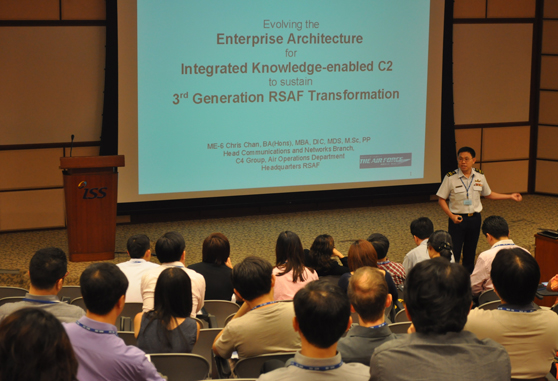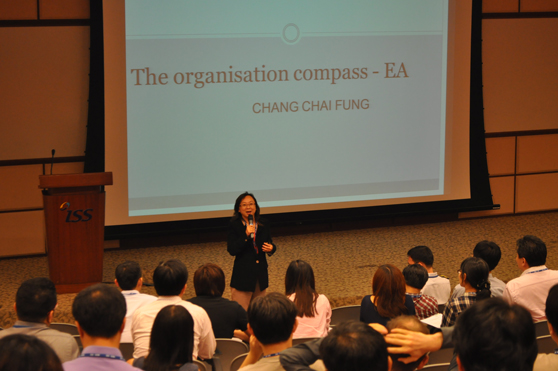Enterprise architecture has the clout to transform an organisation – but it will not be a walk in the park, two speakers told the audience at an event organised by The Architecture Community of Practice (ACoP).
The two speakers were Chang Chai Fung, the Assistant Director (Competency Development) of Human Resource Department at Defence Science and Technology Agency; and Chris Chan, the Head of Communications and Network Branch, C4 Group, Air Operations Department. The pioneer behind the implementation of enterprise architecture in the Republic of Singapore Air Force (RSAF), Chris is a two-time recipient of the Defence Technology Prize in recognition of his leadership in the conceptualisation and implementation of Integrated Knowledge-enabled Command and Control concepts for war-fighting systems deployed in the 3rd Generation RSAF.
Chris revealed how enterprise architecture is helping the air force sustain the transformation of the 3rd Generation RSAF. This transformation is characterised by a fundamental restructuring of the command structure and operational philosophy enabled by cutting-edge Integrated Knowledge-enabled Command and Control concepts built on enterprise architecture.
In RSAF’s transformation, enterprise architecture played two critical roles. First it reduces the complexity of the transformation by controlling the ‘unknown’ zone, by allowing for information-driven transformation and by shifting the paradigm from base-centric to mission-centric.

Above image: Chris shares how enterprise architecture helps the air force sustain the transformation of the 3rd Generation RSAF
Secondly, it enables Integrated Knowledge-enabled Command and Control by allowing for building in the ‘known’ zone and by offering a common inter-operability/integration framework.
Finally Chris spelled out the ‘strategic value’ that enterprise architecture offers an IT practitioner. It gives him a top secret, “God’s eye view” of his organisation. And it allows him to engage key stakeholders in strategic conversations.
Meanwhile Chai Fung pointed out to the audience that enterprise architecture is not just a framework for standardisation and documentation; it is a compass that will point out the true north for successful organisational transformation.

Above image: Chai Fung "What you have to do is identify a gap in the organisation that can be fixed quickly that would either add efficiency or lower cost.”
It can provide the organisation with insights, foresights and oversights essential to effectively manage an enterprise in a dynamic changing environment. However, to do this, the enterprise architect has to be able to connect with the management and sell this transformative ability of enterprise architecture to the management so that they support this endeavour, she added.
To win the management, said Chai Fung, speak the language of the CEO. Don’t lose him in diagrams and flow charts. To understand the language her CEO speaks, Chai Fung studied his speeches and researched keywords in those speeches.
Another tip: Get in a few quick and visible wins to demonstrate what enterprise architecture can do for the organisation. Elaborated Chai Fung, “What you have to do is identify a gap in the organisation that can be fixed quickly that would either add efficiency or lower cost.”
The Architecture Community of Practice (ACoP) is made up of passionate professionals specialising in enterprise, business, information, application, technology and solution architectures. ACoP was formed with the objective of promoting the advancement of the architecture practice through sharing, learning and support in the vibrant network of practitioners. Interested to attend future events such as this? Get in touch with ACoP at isstet@nus.edu.sg.
We received good feedback from our participants on the seminar.
“Real life examples and tips were great.”
Muhammad Iqbal, AUP IT, Barclays
“New concepts, different views and experience.”
Bair Roland , Enterprise Application Architect, Global Blue
“Learning points from practitioners.”
Spencer Low, App Consultant , InfoComm Development Authority of Singapore
This article is first published in NUS-ISS quarterly e-newsletter, Issue 3 (Jul-Sep 2013).